Stereo Photography: A Look at the Origins of 3D Images
![]()
Virtual reality, or VR, is not a new thing. The idea that our left eye and right eye see the same thing from slightly different angles and that our brains combine these two distinct images in such a way that we can see in three dimensions has existed since at least the early 19th century. It was first demonstrated by Sir Charles Wheatstone in 1838.
Over the years, many types of dual-lens cameras have been designed to make 3D or stereoscopic photographs. A single camera can also be used by using a slider or even manually shifting a few inches to make the stereo pair.
Just about every 19th-century camera manufacturer made purpose-built stereo cameras with dual lenses. Here is Eastman Kodak’s entry from 1917. This camera made stereo pairs in the standard stereo card format on size 101 film.
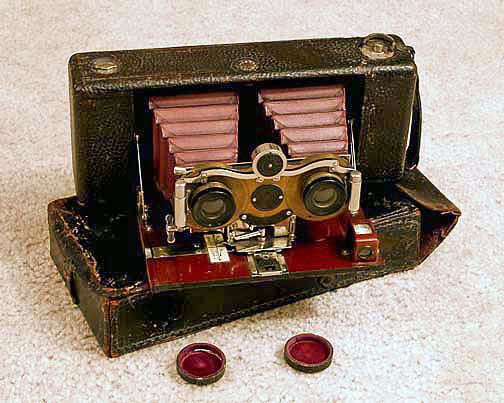
Stereo Photos Lift Off in the Mid-1800s
Beginning in the 1850s, the idea of stereo photographs really began to take off. Stereo is the Greek word for solid or three-dimensional. From the 1850s through the 1930s, just about every middle or upper-class home had at least one stereoscopic viewer and a collection of stereoviews.
Billions of stereoviews were made in several formats over that 80-year period. Selling stereo cards at their photographic studios, in drug stores, and in gift shops was a major source of income for many professional photographers throughout the last half of the 19th century.
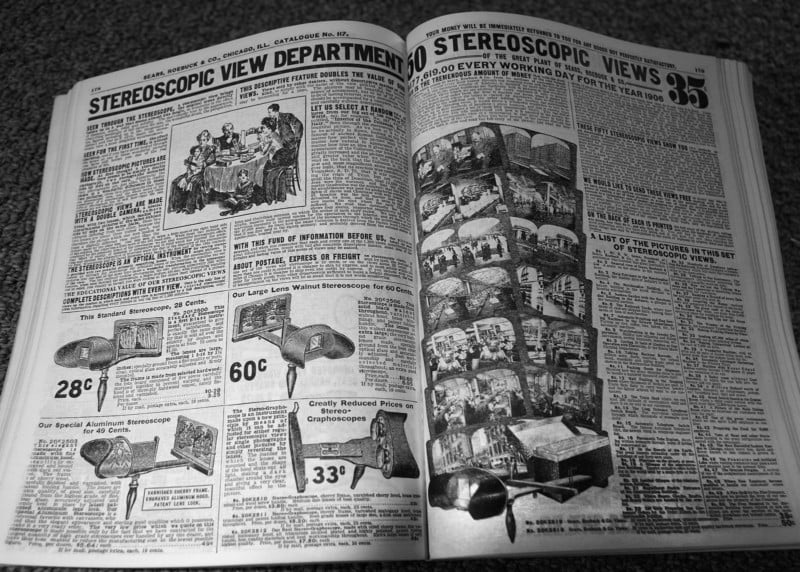
Major publishing companies began getting involved in making stereoviews by the millions. The biggest publishers were Keystone and Underwood & Underwood. These companies also sold viewers in all qualities and price ranges. The 1908 Sears and Roebuck catalog has viewers from 28 cents to 60 cents and six pages of stereo views featuring a wide variety of subjects.
The Keystone Tour of the World came in various collection sizes from 300 to 1200 cards. This is the 600-card Tour of the World.
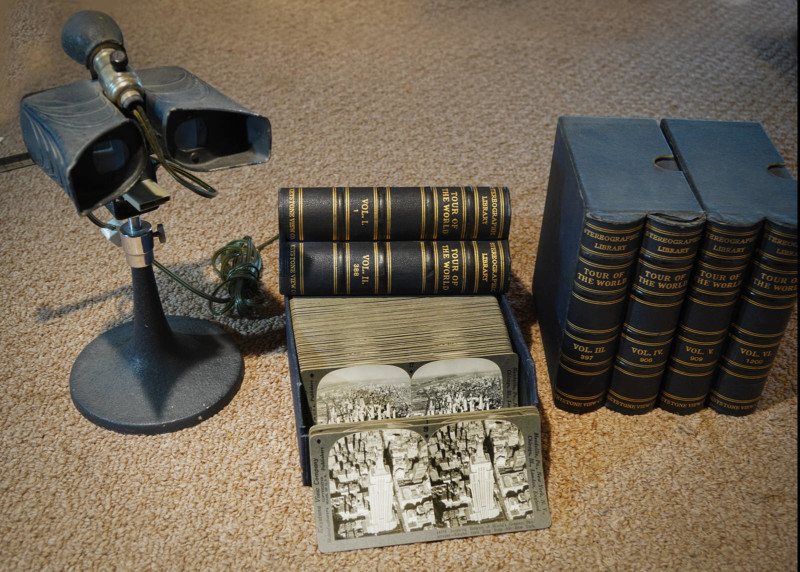
One of the most common types of stereo viewers was the Holmes Viewer invented by Dr. Oliver Wendell Holmes Sr. He was a physician, writer, poet, inventor, and polymath. His eldest son, Oliver Wendell Holmes Jr became a lawyer and Supreme Court Justice.
![]()
Travelers would routinely buy stereo cards as souvenirs, much like they would postcards in later years. Stereoviews of national parks such as Yellowstone and Yosemite are still quite prevalent in antique stores and flea markets.
Here is a stereoview of a photographer photographing Yosemite Falls published by Underwood & Underwood in 1902.
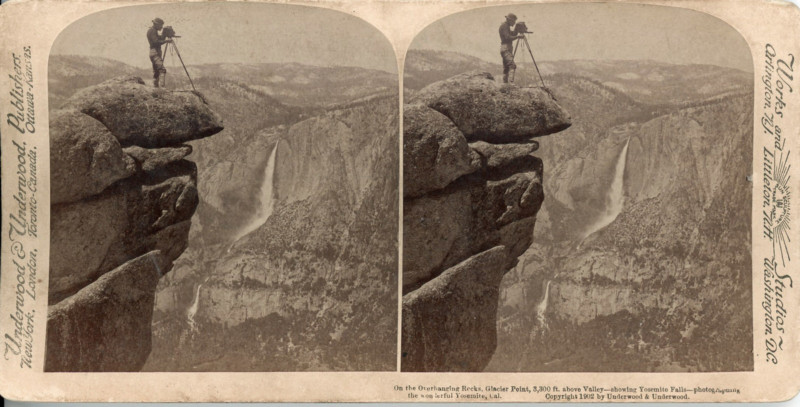
Many stereoviews were of novelty subjects or even portraits and industrial in nature. Here is a stereoview of a child looking at stereoview while apparently using a “potty chair.”
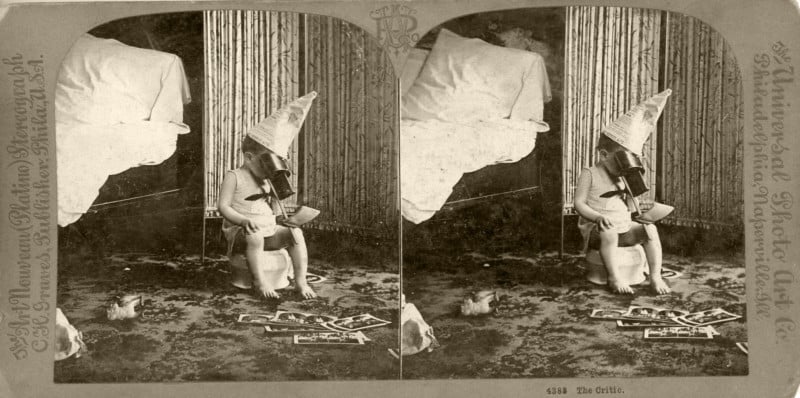
Other formats of stereo have been developed and widely used, especially in Europe. Here is a Le Plistero viewer made in Paris. It is for viewing 120-size transparencies in stereo pairs.
![]()
A Decline and Revival in the 1900s
The height of the stereo card sales and viewers was in the 1890s. The great depression of the 1930s put the big stereo publishers out of business, though the end of the era was already in view.
The 1950s saw a revival of stereo photography using 35mm slide film. 35mm stereo cameras were sold by several companies and Kodak would mount the Kodachrome slides in standardized mounts to be viewed in stereo. The largest manufacturer of stereo cameras and viewers was Realist.
![]()
![]()
This is a Russian-made stereo Sputnik camera from 1960 that makes a stereo pair on 120 film.
![]()
The Post World War II era also saw the emergence and long-term popularity of another stereo format, the View-Master. We often think of the View-Master as a toy because it was inexpensive and popular with the younger set. People who grew up in the 1950s almost always have fond memories of the View-Master they had as a child. Fewer people knew that View-Master also made cameras of the same format and would process Kodachrome slide film, mounting them in the round View-Master slides.
Modern Stereoviews and Further Reading
Bringing the stereoviews to our current day, one of the coolest apps to appear recently is 3DStereoPro. It is available for both Android and iPhone users and allows any smartphone to make wonderful stereo images. The stereo images can be viewed right on the phone using any of the viewers used for the vintage stereo cards, or the files can be printed directly to the old stereo format.
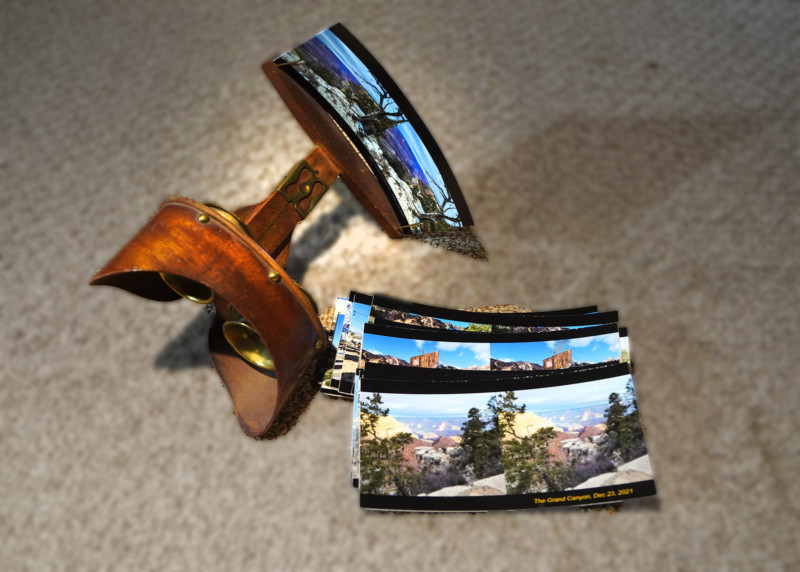
A leading book about stereoviews is Stereo Views, an Illustrated History and Price Guide by John Waldsmith.
![]()
Many people still love making stereo images and organizations exist to promote stereo photography. One is the National Stereoscopic Association, which publishes a magazine and holds a national convention.
The London Stereoscopic Company based in England is also a major promoter of stereo photography.
According to the London Stereoscopic Company, June 21st is Stereoscopy Day, “Stereoscopy Day is an international celebration of the birth of stereoscopic 3D. It takes place annually on the 21st of June, the anniversary of the day in 1838 when Sir Charles Wheatstone officially presented his stereoscope and demonstrated his theory of binocular vision.”
The president of the London Stereoscopic Company is Brian May, the astrophysicist and lead guitar player for the rock band Queen.
The idea of stereo imaging may go back to 1838, but the idea keeps resurfacing not only by people who enjoy the vintage photographs and viewers and by people who are making modern stereo images in the old formats, but also by those working in the most current versions of 3D photography: VR.
Image credits: Photographs by Jim Mathis